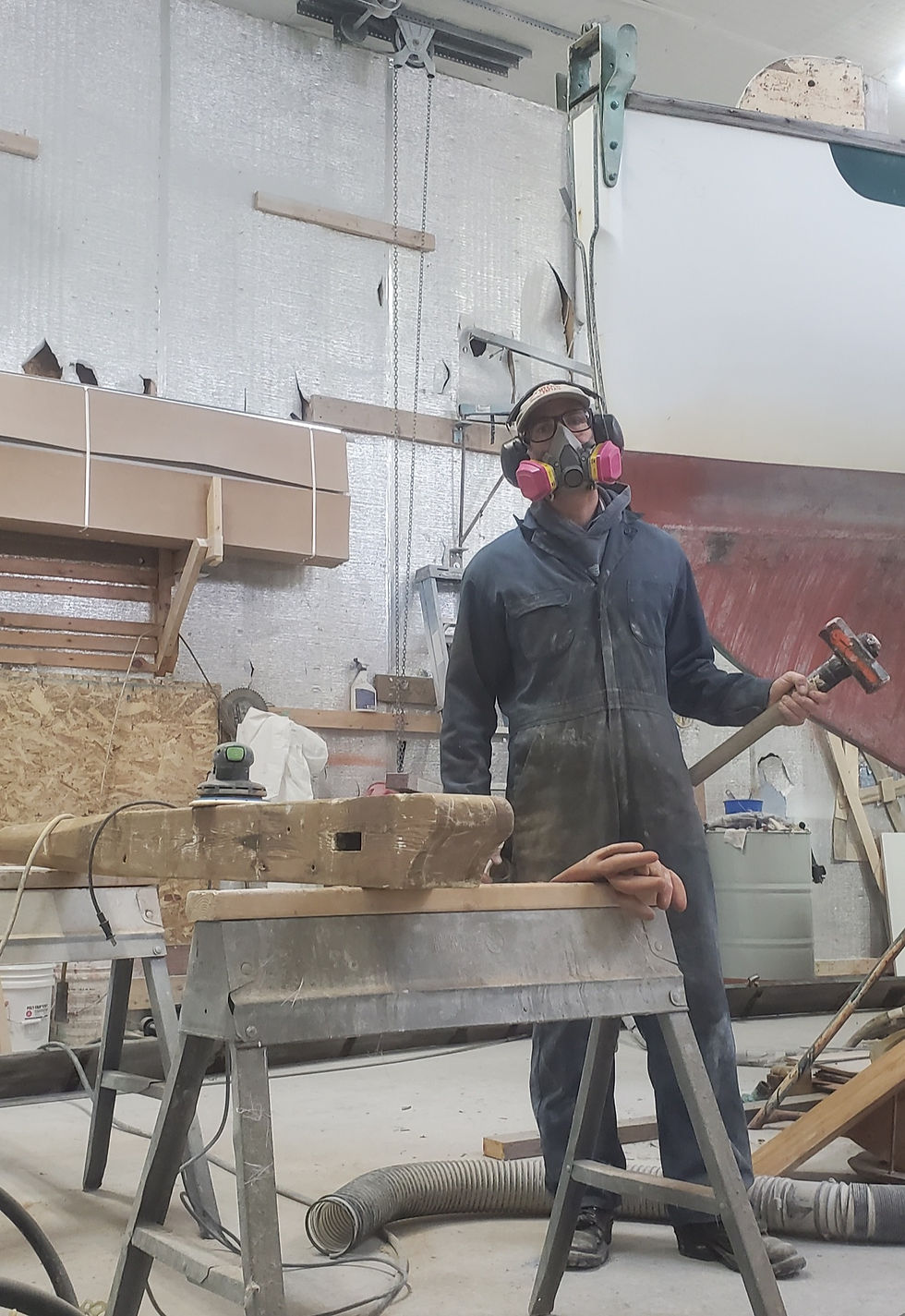What Thou Lovest Best
- Jon Keller

- Apr 21, 2024
- 10 min read
Updated: May 1, 2024

An email from woodworking neighbor Jack—CIA Interrogator (rumored), retired: “What does Montana horse stuff have to do with sailing?”
Answer: Many of the mule packers and wagon drivers had begun their lives as sailors. The freight haulers moving dunnage west—or maybe east out of San Francisco, or high into the hills to supply miners and loggers—had once been crew aboard sailing vessels. And so it follows that the knots used when packing mules began their careers as knots aboard sailing vessels.
I’ve witnessed too many pleasure craft captains who simply cannot tie a knot. As neighbor Donna (runner and shearer of sheep, unretired) says, I have no opinion about that.
Like most things in my life, I’ve done it backwards: I came to ocean sailing from a mule packing past. I took mule packing knots and brought them back across the Continental Divide and slung them suckers first on a lobster boat, then on sailboats. Kind of like the hero in Tales From Margaritaville. Tully Mars, I believe his name was. He takes his horse from Montana to the Gulf Coast, loads it on a shrimp boat, and ends up on the beaches of Mexico. Pretty good read, if you go at it without thinking you know something about its author.
So that’s one link. CIA Jack can rest easy now. Until I sneakily leave the crank handle on his pepper mill askew.
Another one, of course, being the work ethic and determination that one needs for both endeavors, especially if one doesn’t have the cash to hire-out help whenever a problems arises. And, similarly, both are forms of wilderness travel, where sometimes money just don’t mean shit because you’re all alone and far away and things need to be taken care of. A wallet full of cash isn’t going to help get the packs off a mule who’s fallen over in a flooding river and can’t regain its feet any more than it will help get a sail down at 3 in the morning when the wind is raging, although it will help to buy a fancy system that can potentially make reefing or dropping a sail easier (but not simpler)… until that system malfunctions, which systems tend to do. (Yesterday was the ten year anniversary of the BP oil spill.) . As Neighbor Jack said about the container ship running into the Francis Scott Key bridge, “Everything man-made can fail.”
Ahh, but not the singing of the birds, the crashing of the waves, the fluttering notes of Jerry on the guitar. Those don’t fail. Except for a note or two from Jerry, potentially.
And lastly. One of the things that’s had me thinking about guiding in Montana of late is that I’m going to be guiding here in Maine, only this time captaining a sailboat instead of a horse. As Captain Ron once said, “Hard to ride a horse in a speedo, Swab.”
All of which is meant to bring me back to the boat. Polaris Jack. When I last left off about the refit, or rebuild, or whatever the yachty folks want to call it, I’d cut the floor out and pulled the water tank out, a process not unlike gutting an elk, sans the meaty reward and mountain scape.
This was late last January. 2023.
Peter Taylor’s the owner of Taylored Boats here in Addison—and at that point, one of two employees because the lobster industry was experiencing a lull and very few were working on their boats.
Why the lull? In part, because the endangered right whale has been getting a bit of attention, and some fingers are being pointed at lobstermen for potential rope entanglements, and the industry has made it onto a list or two “red flagging” them as a not-so-cool industry. I have no opinion. But I do have an opinion here, blasphemous as it may be: a red flag should be waved concerning the amount of trash them boys both lose and intentionally throw overboard. It's uncanny.

Of course, the cruise ship industry should be hidden beneath a mountain of red flags.
The boat. I’d never hired anyone to work on my boat before. I’ve done it all myself, and I have not enjoyed it, and so having a knowledgable boat worker to not only do the work, but to do the research and make the decisions and shoulder the brain cramps associated with the project—the myriad, quicksand-quagmire, nightmare logistics involved—that was great. I went all-in. Gave Peter the reins. The work on the boat is one thing for me; I can do that. The screw guns and caulking and wrenches and all of that; I don’t like it—and I flat loathe fiberglass or the grinding of fiberglass—but I can do it. The logistics… researching NPT threads vs SAE or what hose to use where or how far the mixing elbow should be from the waterline and wires and radio interference and varnish vs oils and composites and backflow and the fluid dynamics of pumps and all of that shit makes my eyes cross. Give me a horse and a mule and some ropes and a saddle, thank you. One would think a ship powered by a sail to be a simple creature.
That said, my life as a mule packer was simple because others were dealing with the logistics; I just had to show up and put stuff on a mule and get it down the trail. No NPT threads involved.

So, a big part of what I was paying Peter to do was all of those logistics; I wanted that weight off of my shoulders. I had a lot to do outside of the boat—I was studying for my Captain’s exam, building a house, building a website... So, I stepped back, and whenever Peter asked something of me, I said, “Whatever you think is best.”
And I learned a good lesson in doing so. Plus, it didn’t get me out of the boat shop or away from the boat work. Not for long. I did all of the taking apart of the boat, and I left the fiberglass work to him. The sanding and grinding and working with the resins and all that nastiness that he loves.
He’s good at it. Very good. He'd never worked on a sailboat in his life, and though boats are boats, some things are different--sailboats heel over on their sides, and don't always have their engines running, so that makes for a particular set of logistics.
And, of course, it didn't all come out perfect; he and I both made some real mistakes, and there's plenty that I'd do differently the next time around. Like plenty of other things in life.
But, as an old-time mule packer named Kenny once said when the person he was buying a horse from asked him if he wanted to ride it before paying and loading it in his trailer, “I’m guessing that if you can ride it, I can ride it.”
Click through the pics below to enlarge them.
While Peter was working on the water tank replacement--a fiberglass tank coated in a crazy expensive food-grade epoxy (another rabbit hole of research I had to go down)--I began taking the outside of the boat apart in earnest. One of the major issues with Polaris Jack was that the hull-to-deck joint leaked, and water was constantly running down the inside of the hull, ruining the woodwork, corroding any nearby metal, and making for a generally moist, salty environment. Not cool.
First, I removed the bowsprit, which involved removing all of the hardware attached to it—the attachment point for the headstay and bobstays, the anchor yoke, the huge, bronze windlass (a winch to haul the anchor in). Then the bulwarks themselves, which are the teak planks that form side rails, or wash rails, down the entire length of the boat. This was major surgery, and although I was able to take them off in a day, it would take full days to re-install them. Not to mention the fact that I now had 26’ long x 8” tall teak planks to deal with. And it’d prove to be a long, long time until they got put back on.
I stowed them aboard the boat for the boat’s trip to the town parking lot, then the boat hauler, Adam, stopped at the end of my road so we could unload the teak bulwarks onto a trailer, and friend Donna and I brought them down my little dirt road and into my under-construction-house, where they’d spend the winter.
Then, after 8 or so coats of tung oil—and an arduous amount of research on what best to use to preserve said teak—I rounded up three other friends and we tied straps from one bulwark to another, shouldered them, and carried the cursed things a mile and a half down the road to where the boat was still sitting. Two 26’ long planks, one on each side of us, four of us in a line.
A local lobsterman stopped and said, “Are you trying to make yourselves look foolish? Next time, call me. I have a big trailer.”
Ahh, but as the old poet, Sisyphus, said, Anyone can do things the easy way.




As for the tung oil… How to best treat wood is a mega-debate in the boat world. Some say that teak doesn’t need anything, just let it go gray; that was once true, but the teak used in the 70’s and 80’s wasn’t the same as the teak in the old days, when that saying came into being. Similarly, those salty old sailors soaked their teak in saltwater daily, thus imbuing it with salt as a preservative.
In the last half century, the teak has been farmed, so it’s a different wood altogether. Similarly, sailboats tend to spend more time tied-up and being rained on than they do being salt-soaked on the open ocean.
Some folks just love varnish, so it’s a no-brainer. They need the wood to shine and glisten and all that. It’s just a lot of labor. I went with tung oil for the bulwarks because it’s non-toxic, soaks into the wood to moisturize the wood, and it goes on easily. I’ll have to redo it a couple times a year, but that just means a scrub and a couple more coats. Varnish is toxic, needs sanding and all kinds of babying, and is more of a coating than a penetrator.
Alas, I did use it on several parts that I wanted to seal / waterproof, and Jack used it on the parts he built because they’re encased in epoxy, and epoxy needs varnish to cover it so that the UV doesn’t break it down.
I used to read all those great novels and poems; now I read about frigging varnish and epoxy. Tactile stuff, one might say. Whatever. Not cool.
These Bristol Channel Cutters are known for the woodwork, so I had to do something; Polaris Jack spent her entire life in the south, and the teak showed its age—the sun broke it down and the wind blew it away. Literally. In measurable quantities.
The hull-to-deck joint (they build the hull, like a bowl, then the top, like a lid, and then glue and bolt the two together) that leaked was further inlaid with intricate teak, all of which was glued and screwed so thoroughly that I couldn’t even begin to remove it without destroying it. I spent a lot of time trying to save it. Days of carefully trying to remove screws, break glue joints, save specific lengths of teak. But nothing could be done. Click on these pics (and others) to enlarge. The last one here shows the glassed-over section, and a fiberglass block to hold the stanchion posts.
So I got the pry bar out. It was a long, arduous experience, and hard on the soul, this breaking apart of a sailboat. That, and the air in the boat shop was so latently toxic that I wore a respirator any time I was in there. I guess OSHA ignores Washington County, what with it being so poor that the people’s safety doesn’t really matter, so these boat shops are insane. The air is literally impregnated with fiberglass dust and resin fumes. Peter once told me that when he goes on vacation, it takes 4 or 5 days for his body to purge the fiberglass smell, and his wife always tells him when he no longer carries the odor.
That’s scary shit right there. But Peter says he read an article put out by the British government saying that studies show that fiberglass isn’t bad for you.
Huh?
At my old buddy Spencer’s boat shop, I’d see guys grinding fiberglass with no masks or anything, and they’d step outside, their faces totally covered in white powder, only a couple wet spots below their nostrils showing skin. One of the reasons that the average life expectancy for Washington County males is that of 3rd world nations.
I ain't no doctor, but I do know that Spencer died in his mid-fifties of leukemia.
Which is to say, even with a respirator on, I hated being in there. It’s no fun wearing a respirator. And it’s no fun being in a toxic place. No animal can be healthier than their environ.
And so part of the reason I told Peter to use his judgement on what he did to my boat was that I didn’t want to be in that shop any more than I had to be, and also, he didn’t make enough money for what he was doing. He charged me $65 per hour, which included the shop space and all of his tools. And I’d see him stuffed in some spot on my boat, grinding fiberglass, covered in that shit all day, and my attitude was: Do whatever you want, buddy. I’ll trust you. And if I pay extra here and there, it’s worth it.
I stand by that attitude, though I’d make some changes next time around. I’d have tighter guidelines, a clearer plan; but I did my best, and a plan has to evolve as new information presents itself. Beware, oh wanderer. The boat is wandering too. That’s Eminem, I think.
The bowsprit had numerous coats of paint piled on it, and like the boomkin, water had seeped under the paint and begun to cause rot. I got some citrus paint stripper and went to town on it. The stuff worked, and I scraped and sanded the bowsprit down to bare wood, then brought it to Jack, who was hard at work on the boomkin at this point.

We stood the bowsprit in the corner of his shop and he and I watched it dry for a month or so in order to relax. It looks like either Sitka spruce or Douglas-fir. Probably fir, though Doug-fir isn’t a true fir.
Then, after lots of back and forth about what to do with it, Jack and I decided to epoxy it and paint it again. The wood didn’t look good after all the paint removing I’d done, so the oil that’d been my inclination would’ve looked flat awful.
With the bowsprit set-aside, and the bulwarks off, and the teak trim off the hull/deck joint, I was finally able to step out of the shop for a while and finish working on my captain’s license course.

Peter sanded the hull/deck joint clean and fiberglassed around the entire perimeter of the boat (see the pictures up above), thus sealing the hull to the deck in fine fashion. He also got the water tank in, and the floor.
So. In the end, some major accomplishments, but those accomplishments left a massive amount of work for me to do to get the boat put back together. I’m on the job, and accepting applications for volunteers.

And: if you want to subscribe to this stuff, go to the main blog page and do so. And share away.




































Comments